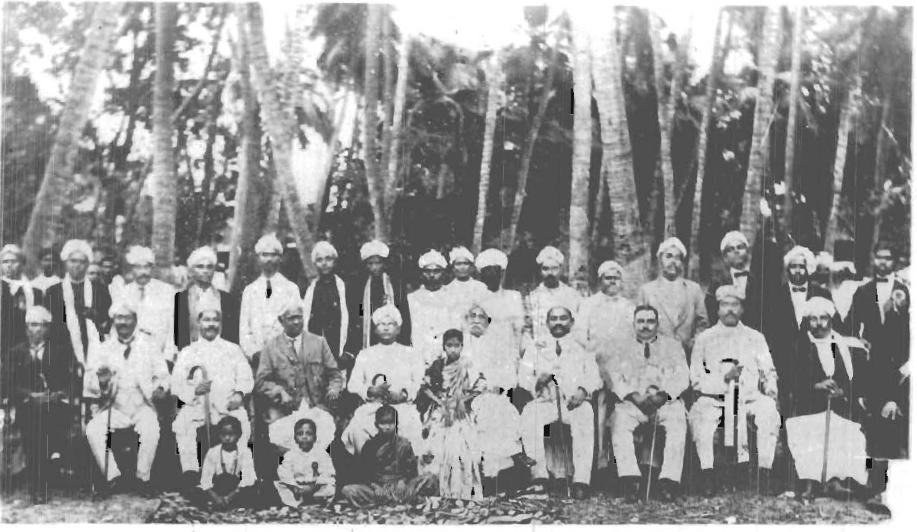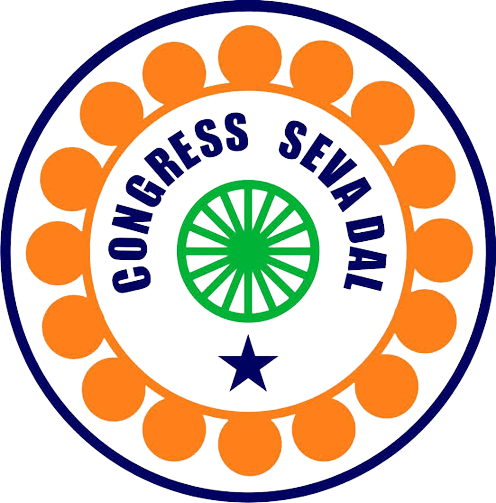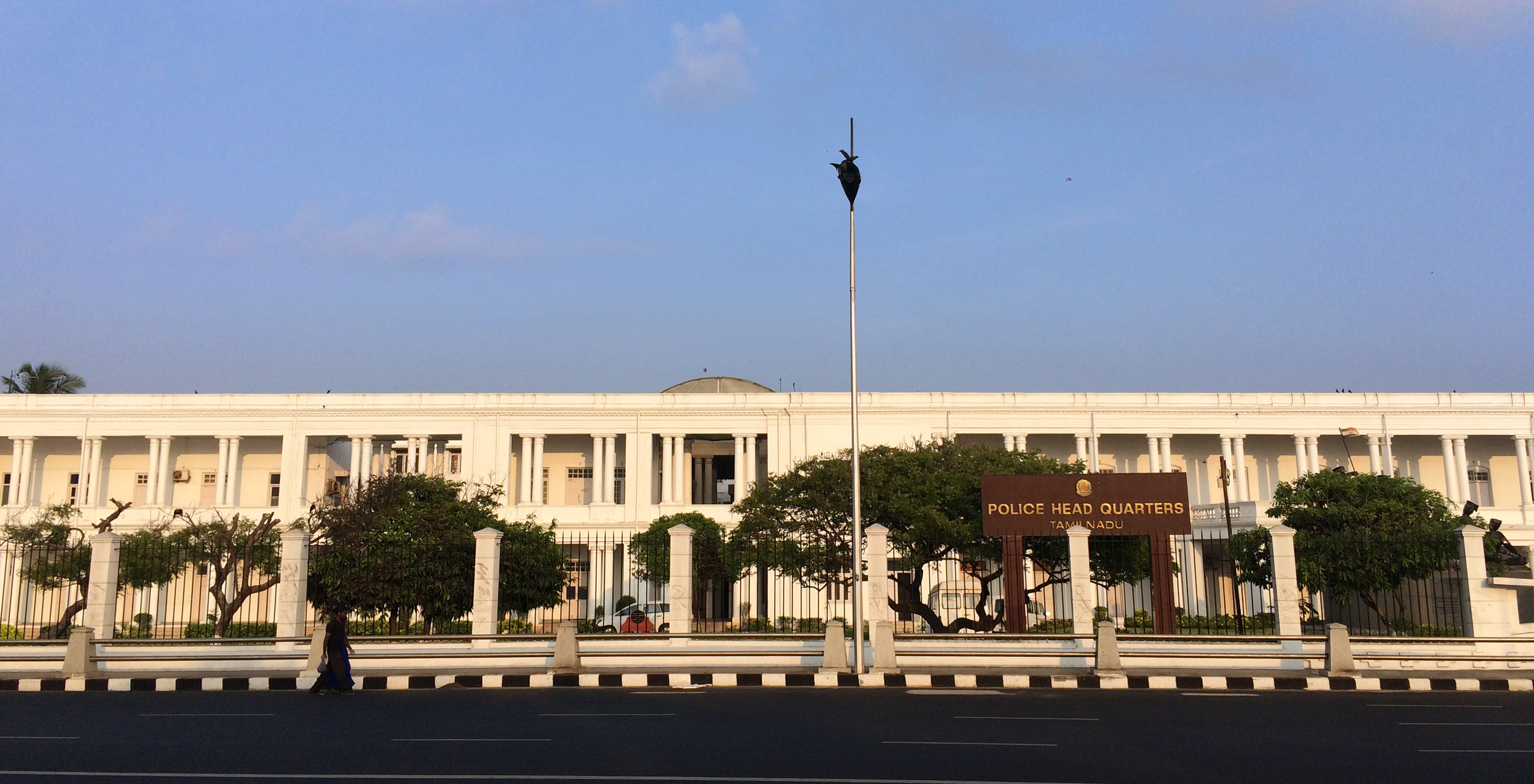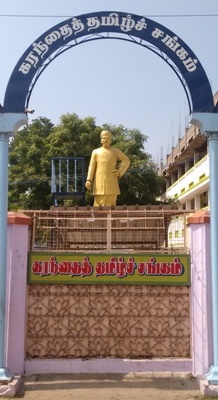|
Anti-Hindi Agitation Of 1937β1940
The anti-Hindi imposition agitation of 1937β1940 refers to a series of protests that happened in Madras Province of British India during 1937β1940. It was launched in 1937 in opposition to the introduction of compulsory teaching of Hindi in the schools of the province by the Indian National Congress government led by C. Rajagopalachari (Rajaji). This move was immediately opposed by E. V. Ramasamy (Periyar) and the opposition Justice Party (later Dravidar Kazhagam). The agitation, which lasted for about 30 months, was multifaceted and involved fasts, conferences, marches, picketing and protests. The government responded with a crackdown resulting in the death of two protesters and the arrest of 1,198 persons including women and children. The mandatory Hindi education was later withdrawn by the British governor of Madras Lord Erskine in February 1940 after the resignation of the Congress government in 1939. Background The Republic of India has hundreds of languages. Accordin ... [...More Info...] [...Related Items...] OR: [Wikipedia] [Google] [Baidu] |
Madras Province
The Madras Presidency or Madras Province, officially called the Presidency of Fort St. George until 1937, was an administrative subdivision (province) of British India and later the Dominion of India. At its greatest extent, the presidency included most of southern India, including all of present-day Andhra Pradesh, almost all of Tamil Nadu and parts of Kerala, Karnataka, Odisha and Telangana in the modern day. The city of Madras was the winter capital of the presidency and Ooty (Udagamandalam) was the summer capital. The Madras State was neighboured by the Kingdom of Mysore to the northwest, the Kingdom of Cochin and Kingdom of Travancore to the southwest, the Kingdom of Pudukkottai in the center, and the Hyderabad State to the north. Some parts of the presidency were also flanked by Bombay State ( Konkan Districts) and Central States (modern Madhya Pradesh). In 1639, the English East India Company purchased the village of Madraspatnam and one year later it established the ... [...More Info...] [...Related Items...] OR: [Wikipedia] [Google] [Baidu] |
Justice Party (India)
The Justice Party, officially the South Indian Liberal Federation, was a political party in the Madras Presidency of British Raj (current Tamil Nadu, India) It was established on 20 November 1916 in Victoria Public Hall in Madras by Dr C. Natesa Mudaliar and co-founded by T. M. Nair, P. Theagaraya Chetty and Alamelu Mangai Thayarammal as a result of a series of non-Brahmin conferences and meetings in the presidency. Communal division between Brahmins and non-Brahmins began in the presidency during the late-19th and early-20th century, mainly due to caste in India, caste prejudices and disproportionate Brahminical representation in government jobs. The Justice Party's foundation marked the culmination of several efforts to establish an organisation to represent the non-Brahmins in Madras and is seen as the start of the Dravidian Movement. During its early years, the party was involved in petitioning the imperial administrative bodies and Government officials demanding more represe ... [...More Info...] [...Related Items...] OR: [Wikipedia] [Google] [Baidu] |
Seva Dal
The Seva Dal is an organization of the Indian National Congress. The organization has a chapter in all the states of India. The members of the organization are known for wearing the Gandhi topi. It is headed by a Chief Organiser Shri Lalji Desai History In 1923, following the Flag Satyagraha at Nagpur, many activists of the Congress were arrested and sentenced to prison. Unable to tolerate the conditions of the prison, most of them tendered written apologies to the colonial authorities. However, members of the Hubli Seva Mandal, founded by N. S. Hardikar did not submit apologies. This position gained the attention of the Congress's national leadership that had gathered in Nagpur to participate in the satyagraha. It was here that the idea of establishing an organisation of volunteers to combat the Raj was formed. At the Kakinada session of the Congress in 1923, a board under Dr. N. S. Hardikar was constituted for establishing the Seva Dal. The Seva Dal was established a ... [...More Info...] [...Related Items...] OR: [Wikipedia] [Google] [Baidu] |
Indian National Congress
The Indian National Congress (INC), colloquially the Congress Party, or simply the Congress, is a political parties in India, political party in India with deep roots in most regions of India. Founded on 28 December 1885, it was the first modern Nationalism, nationalist movement to emerge in the British Empire in Asia and Africa. From the late 19th century, and especially after 1920, under the leadership of Mahatma Gandhi, the Congress became the principal leader of the Indian independence movement. The Congress led India to independence from the United Kingdom, and significantly influenced other Decolonization, anti-colonial nationalist movements in the British Empire. The INC is a "big tent" party that has been described as sitting on the Centrism, centre of the Indian politics, Indian political spectrum. The party held its first session in 1885 in Mumbai, Bombay where Womesh Chunder Bonnerjee, W.C. Bonnerjee presided over it. After Indian independence in 1947, Congress eme ... [...More Info...] [...Related Items...] OR: [Wikipedia] [Google] [Baidu] |
Flag Of Indian National Congress
A flag is a piece of textile, fabric (most often rectangular) with distinctive colours and design. It is used as a symbol, a signalling device, or for decoration. The term ''flag'' is also used to refer to the graphic design employed, and flags have evolved into a general tool for rudimentary signalling and identification, especially in environments where communication is challenging (such as the Maritime flag, maritime environment, where Flag semaphore, semaphore is used). Many flags fall into groups of similar designs called flag families. The study of flags is known as "vexillology" from the Latin , meaning "flag" or "banner". National flags are patriotic symbols with widely varied interpretations that often include strong military associations because of their original and ongoing use for that purpose. Flags are also used in messaging, advertising, or for decorative purposes. Some military units are called "flags" after their use of flags. A ''flag'' (Arabic: ) is equival ... [...More Info...] [...Related Items...] OR: [Wikipedia] [Google] [Baidu] |
Tamil Nadu Police
Tamil Nadu Police is the primary law enforcement agency of the state of Tamil Nadu, India. It is over 150 years old and is the fifth largest state police force in India.Tamil Nadu Police Tamil Nadu has a police-population ratio of 1:632. The Director General of the Tamil Nadu police is Shankar Jiwal. Organization Police Headquarters The Tamil Nadu Police is headed by the Director General of Police (DGP). The DGP has the designation of Head of Police Force (HoPF) and is assisted by special and additional DGPs. The current DGP is Shankar Jiwal, IPS. The headquarters is also the office of the DGP and is situated in Chennai, the state's capital. The HQ oversees and coordinates the overall functioning of the police force in the state. For administrative purposes, the state has bee ...[...More Info...] [...Related Items...] OR: [Wikipedia] [Google] [Baidu] |
Government Of Tamil Nadu
The Government of Tamil Nadu () is the administrative body responsible for the governance of the Indian state of Tamil Nadu. Chennai is the capital of the state and houses the state executive, legislature and head of judiciary. Under the Constitution of India, ''de jure'' executive authority lies with the governor, although this authority is exercised only by, or on the advice of, the chief minister, the '' de facto'' authority and the cabinet. Following elections to the Tamil Nadu Legislative Assembly, the state's governor usually invites the party (or coalition) with a majority of seats to form the government. The governor appoints the chief minister, whose council of ministers are collectively responsible to the assembly. Legislative assembly elections are held every five years to elect a new assembly, unless there is a successful vote of no confidence in the government or a two-thirds vote for a snap election in the assembly, in which case an election may be held soon ... [...More Info...] [...Related Items...] OR: [Wikipedia] [Google] [Baidu] |
Tamil Nadu Emblem
Tamil may refer to: People, culture and language * Tamils, an ethno-linguistic group native to India, Sri Lanka, and some other parts of Asia **Sri Lankan Tamils, Tamil people native to Sri Lanka ** Myanmar or Burmese Tamils, Tamil people of Indian origin settled in Burma/Myanmar primarily during the British period **Tamil Malaysians, Tamil people of Indian origin settled to Malaysia **Singapore Tamils, Tamil people of Indian origin settled in Singapore **Tamil diaspora, descendants of Tamil immigrants living outside of India and Sri Lanka * Tamil language, the native language of the Tamils * Tamiloid languages, Dravidian languages related to Tamil, spoken in India * Tamil script, the writing system of the Tamil language **Tamil (Unicode block), a block of Tamil characters in Unicode * Tamil dialects, referencing geographical variations in speech * Tamil culture, culture of the Tamil people * Tamil cuisine, cuisine of the Tamil people * Tamil cinema (other) **Tamil cinema ... [...More Info...] [...Related Items...] OR: [Wikipedia] [Google] [Baidu] |
Shaivism
Shaivism (, , ) is one of the major Hindu denominations, Hindu traditions, which worships Shiva as the Para Brahman, supreme being. It is the Hinduism#Demographics, second-largest Hindu sect after Vaishnavism, constituting about 385 million Hindus, found widely across South Asia (predominantly in South India, Southern India), Sri Lanka, and Nepal.Keay, p.xxvii. The followers of Shaivism are called Shaivas or Shaivites. According to Chakravarti, Shaivism developed as an amalgam of pre-Aryan religions and traditions, Vedic Rudra, and post-Vedic traditions, accommodating local traditions and Yoga, puja and bhakti. According to Bisschop, early shaivism is rooted in the worship of vedic deity Rudra. The earliest evidence for sectarian Rudra-Shiva worship appears with the Pasupata (early CE), possibly owing to the Origins of Hinduism, Hindu synthesis, when many local traditions were aligned with the Brahmanism, Vedic-Brahmanical fold. The PΔΕupata movement rapidly expanded through ... [...More Info...] [...Related Items...] OR: [Wikipedia] [Google] [Baidu] |
Karanthai Tamil Sangam
Karanthai Tamil Sangam is a Tamil language society in Tamil Nadu, India. The society was founded in 1911 to promote the language. It is one of the modern Tamil Sangams. History Karanthai Tamil Sangam was founded on 14 May 1911 in Karanthattankudi (also known as Karunthattaikudi and Karanthai), a suburb of Thanjavur, Tamil Nadu. The society was founded by Radhakrishna Pillai with his brother Umamaheswara Pillai as its first president. The Sangam passed a resolution in 1920 to declare Tamil as classical language. In a meeting on 27 August 1937, it condemned the imposition of Hindi in the educational institutions. Activities The society started a literacy journal ''Tamil polil'' in 1925. It conducts monthly meetings and seminars on Tamil literature. It established educational institutions to provide Tamil education. See also * Madurai Tamil Sangam Madurai Tamil Sangam, also known as the fourth Tamil Sangam, was a language academy founded by Prince Pandithurai Thevar and ... [...More Info...] [...Related Items...] OR: [Wikipedia] [Google] [Baidu] |
Self-Respect Movement
The Self-Respect Movement is a popular human rights movement originating in South India aimed at achieving social equality for those oppressed by the Indian caste system, advocating for lower castes to develop self-respect. It was founded in 1925 by S. Ramanathan, who invited E. V. Ramasamy (also known as Periyar) to head the India against Brahminism movement in Tamil Nadu. The movement was extremely influential not only in Tamil Nadu, but also overseas in countries with large Tamil populations, such as Sri Lanka, Burma, and Singapore. Among Singapore Indians, groups like the Tamil Reform Association, and leaders such as Thamizhavel G. Sarangapani were prominent in promoting the principles of the Self-Respect Movement among the local Tamil population through schools and publications. A number of political parties in Tamil Nadu, such as Dravida Munnetra Kazhagam (DMK) and All India Anna Dravida Munnetra Kazhagam (AIADMK) owe their origins to the Self-Respect Movement; the ... [...More Info...] [...Related Items...] OR: [Wikipedia] [Google] [Baidu] |
Communist Party Of India
The Communist Party of India (CPI) is a political party in India. The CPI considers the Foundation of the Communist Party of India, December 26, 1925 Cawnpore (Kanpur) conference as its foundation date. Between 1946 and 1951, the CPI led militant struggles such as the Telangana Rebellion, peasant revolt in Telangana, organising guerrilla warfare against feudal lords. The CPI was the main opposition party in India during the 1950s to 1960s. In 1964, 1964 split in the Communist Party of India, a split in the CPI led to the formation of the Communist Party of India (Marxist), which eventually emerged as the larger of the two parties. CPI supported the rule of Indira Gandhi, but later changed course and embraced left unity. CPI was part of the ruling United Front (India, 1996), United Front government from 1996 to 1998 and had two ministers under Deve Gowda ministry, Devegowda and Gujral ministry, Gujral Ministry. Currently, the CPI has two members in Lok Sabha and two members ... [...More Info...] [...Related Items...] OR: [Wikipedia] [Google] [Baidu] |







